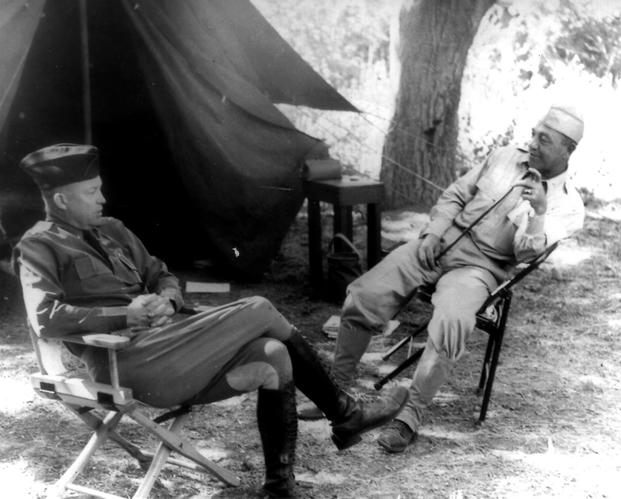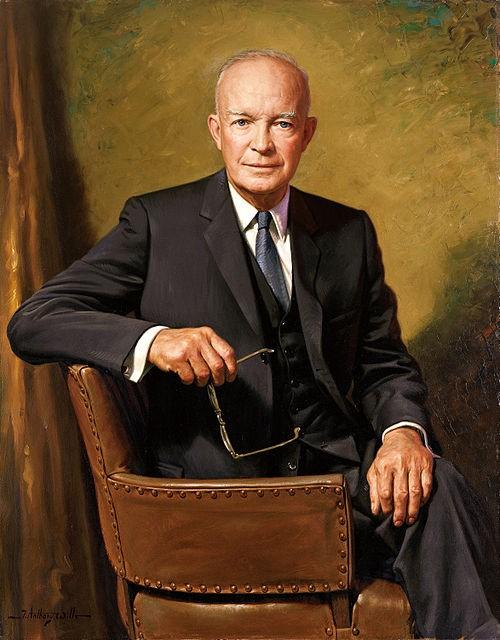Dwight David Eisenhower was born on Oct. 14, 1890 in Denison, Texas 135-years ago. His family later relocated to Kansas. His path from a small-town in Kansas to Supreme Allied Commander in Europe during World War II, and later President of the United States, remains one of the most unlikely stories in military history.
The future five-star general never saw a single day of frontline combat during his 35 years in uniform. Yet he would command the largest amphibious invasion in history and lead the Allies to victory in Europe over the Axis.
Although some would disagree, Eisenhower proved that it’s not combat experience that wins wars, its persistence, logistics, strategy and stellar leadership.
Eisenhower During World War I
After graduating from West Point in 1915, Eisenhower spent World War I moving between stateside posts. He trained infantrymen before they were sent overseas, coached college football and repeatedly requested deployment orders. The Army had other plans.
His superiors recognized something valuable in the young officer. Eisenhower could organize and turn raw recruits into soldiers faster than most officers who’d seen combat. Although an injury stopped his football career, his coaching stints proved he was an efficient strategist and leader of men.
In 1918, the Army sent him to establish Camp Colt near Gettysburg, Pennsylvania — the first U.S. training facility for the Tank Corps. Without actual tanks, he improvised, mounting machine guns on flatbed trucks and leading notional armored assaults. He commanded and trained over 10,000 troops during this time, earning him the Distinguished Service Medal.
Then came the cruelest turn of his military career.
On Oct. 14, 1918 — his 28th birthday — Eisenhower received orders to deploy to France and take command of an armored unit. The departure date was set for Nov. 18. But on Nov. 11, the armistice was signed. The war ended seven days before he could ship out.
“I could see myself, years later, silent at class reunions while others reminisced of battle. For a man who likes to talk as much as I, that would have been intolerable punishment,” Eisenhower later recalled. “It looked to me as if anyone who was denied the opportunity to fight might as well get out of the Army at the end of the war.”
Eisenhower remained with the Army, but the interwar years proved equally frustrating. He held the rank of major for 16 years as promotions stalled across the military.
The Mentors Who Shaped a Supreme Commander
Yet those years shaped him. In Panama, he served under Brig. Gen. Fox Conner, who taught him strategic thinking and military history during long horseback rides through the jungle. Conner warned another world war was coming and told Eisenhower it would require alliances and unified command structures.
Conner took notice of one of Eisenhower’s peers, George C. Marshall, and his rare ability to work with Congress, coordinate with allies and think strategically rather than tactically. Conner would call him the “ideal soldier” and a “genius.” He urged Eisenhower to remain close with Marshall going forward and take many of those same lessons to heart.
Eisenhower later worked for Gen. John Pershing, spending months walking the battlefields of Verdun, the Meuse-Argonne and other WWI sites, studying terrain, logistics and the mistakes that cost hundreds of thousands of lives.
He served as an aide to Gen. Douglas MacArthur in the Philippines from 1935 to 1939, learning how to handle a brilliant but difficult commander and how to build a military force from limited resources — skills he’d later use managing leaders like George Patton and British Field Marshal Bernard Montgomery while coordinating multinational forces.
Although Eisenhower and MacArthur heavily disagreed on leadership principles and despised each other at times, MacArthur’s own evaluations of the young leader noted that he was “brilliant” and “in time of war … should be promoted to General rank immediately.”
When Japan attacked Pearl Harbor, Marshall summoned Eisenhower to Washington. Drawing on his experience in the Philippines, Eisenhower delivered a bleak but accurate assessment of the situation in the Philippines that impressed Marshall.
Within eight months, Eisenhower went from lieutenant colonel to three-star general. In June 1942, Marshall chose him to command U.S. forces in Europe — over 366 more senior officers, most of whom had served with distinction in the trenches of France.

The Leader with No Combat Experience
Marshall had watched Eisenhower work 18-hour days in Washington, drafting comprehensive war plans with precision and speed. He’d seen him coordinate between competing service branches without political infighting. Eisenhower had organizational skills, strategic vision and an ability to work with Allied commanders that few American officers possessed.
His lack of WWI combat experience actually helped him plan accordingly. His thinking wasn’t trapped in the static, trench-warfare mindset that had defined that conflict. He took the lessons of his mentors during the interwar years seriously and was putting that guidance at the forefront of his strategy.
During Operation Torch in November 1942, Eisenhower led Allied forces in the successful invasion of North Africa. He then led Allied troops in the Invasion of Sicily, while managing the bitter rivalry between his subordinates, Montgomery and Patton. Eisenhower even showed his strategic-level thinking by making it a punishable offense for anyone under his command to bad-mouth or berate other nationalities fighting for the Allies.
President Franklin Roosevelt faced a difficult decision in late 1943: Who would command the upcoming D-Day invasion? Marshall was the obvious choice, but Roosevelt couldn’t afford to lose him as chief of staff. Eisenhower had no direct combat experience, but was already leading Allied troops in the theater. When Roosevelt asked Marshall what he wanted, the general refused to lobby for himself.
“Then it will be Eisenhower,” Roosevelt said.
On Dec. 7, 1943, Marshall sent Eisenhower a simple note with Roosevelt’s message to Soviet leader Joseph Stalin announcing the appointment. At the bottom, Marshall wrote: “Dear Eisenhower, I thought you might like to have this as a memento.”

D-Day and the End of the War
The general who had spent WWI training others led the most consequential invasion in military history. On June 6, 1944, he gave the order that launched 150,000 troops across the English Channel into Nazi-occupied France.
In his wallet, he carried a handwritten note he prepared in case the invasion failed. He never had to use it.
“Our landings in the Cherbourg-Havre area have failed to gain a satisfactory foothold and I have withdrawn the troops,” Eisenhower wrote. “My decision to attack at this time and place was based upon the best information available. The troops, the air and the Navy did all that bravery and devotion to duty could do. If any blame or fault attaches to the attempt it is mine alone.”
The landings were a stunning success. Eleven months later, Germany surrendered. The humble soldier from Kansas had become the architect of Allied victory in WWII. At his peak, the five-star general commanded over three-million Allied soldiers as they entered Nazi Germany.

Owing to his success during the war, he later became the 34th President of the United States and led the nation through some of the most tumultuous years of the Cold War. Though he never fought in combat directly, the sacrifice and loss of soldiers under his command weighed on him constantly. He became emotional and shed tears whenever he recalled D-Day and the heroic exploits of his troops.
Eisenhower’s career proved something many leaders of his era refused to admit: Waging war requires logistics, diplomacy, strategic thinking and the ability to coordinate massive operations across nations and continents. Combat experience helps, but isn’t necessary.
Story Continues
Read the full article here



